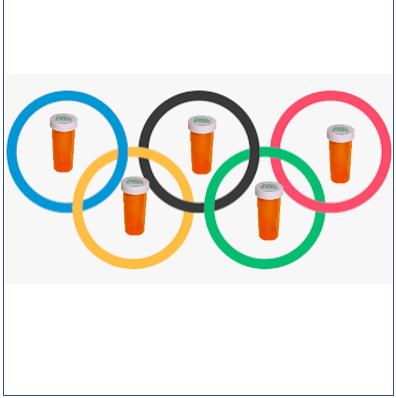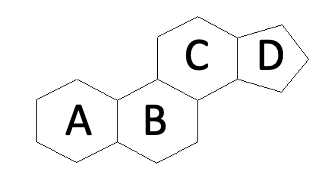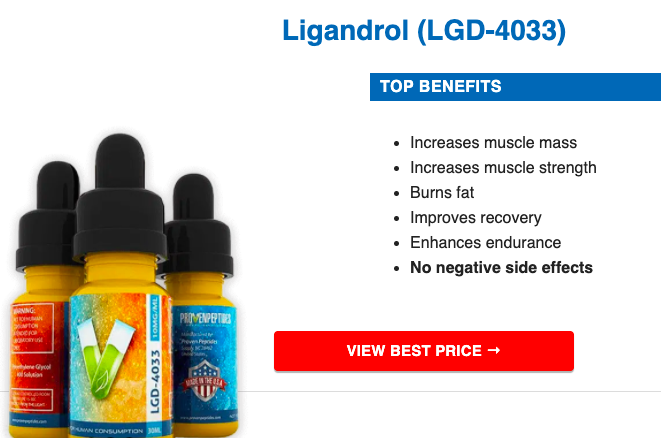
I don't know about you, but I started losing interest in the Olympics when it became apparent that many of the real competitors were pharmacologists, not athletes. Each year the World Anti-Doping Association (WADA), an organization founded by the International Olympic Committee in 1999 to fight the use of drugs in sports, puts out an updated list of drugs – there are about 200 of them – banned from sports worldwide.
The list is impressive; there's all kinds of s### that you don't want to put into your body (1). About what you'd expect: steroids, stimulants, growth hormones, and masking agents (usually diuretics), which can prevent the detection of the listed drugs.
Steroids may not be what you think.
Everyone knows about anabolic steroids – drugs that help build muscle – but there is an interesting twist here. A lesser-known class of drugs called selective androgen receptor modulators (SARMs). From a chemist's point of view, these are fascinating chemicals. They act like anabolic steroids, but not exactly so. And chemically they look nothing like steroids, which have the following framework (Figure 1). More on this later.

Figure 1. Steroids are defined by their chemical structure, not function. The skeleton of all steroids contains the 6-membered rings – all consisting of carbon atoms – fused together with a 5-membered ring. The letters serve as names of the individual rings.
Of course, despite their identical framework, steroids are "decorated" with different atoms, which gives them their properties (Figure 2).

Figure 2. Four common steroids. Although the four may look similar, they have very different properties.
Anabolic steroids – a big no-no
When most people hear the word "steroid," they typically think of testosterone or anabolic (muscle-building) steroids (WADA lists 50 of them), but there are a number of other classes. Neither cholesterol, which is found in all animal cells, nor prednisone, an anti-inflammatory steroid, have properties that would make them of obvious use to Olympic athletes (2).
But anabolic steroids sure help with weight lifting and other sports that require strength. These have almost certainly been the most commonly doping drugs in the history of Olympic sports.

Figure 3. Selected anabolic steroids
TIME FOR A RANT!
I admit it. There are some winter sports I just don't get. Curling is strangely popular, but does this belong in the same competition as the ski jump? And why not modernize the sport and use vacuum cleaners? And the biathlon where the competitors have to ski and shoot. What does shooting have to do with skiing? Why not have them ski and fry an egg? Rant over.
Androgen receptor agonists
Androgen receptors are a subset of steroid hormone receptors (there are 49), which control multiple physiological functions in the body. When an androgen, most commonly testosterone, binds to a receptor it triggers the development of several (usually) male characteristics, such as an increase in muscle mass, hair growth, bone development, puberty, and libido.
This multitude of physiological responses causes unwanted side effects when used as medications for conditions like muscle wasting, osteoporosis, and hypogonadism (insufficient testosterone). These include male pattern baldness, growth of body hair, acne, aggressive behavior, heart disease, and enlarged prostate glands. It sounds like the cure is worse than the disease.
SARMs – "Disguised" anabolic steroids
Even someone with no knowledge of chemistry will be able to see that SARMs look nothing like steroids. Here are three of the dozen or so known SARMs (Figure 4).

Where did these things come from?
Even though their use is illegal, SARMs are the product of bona fide pharmaceutical research. The androgen mimics were designed to treat several conditions, for example, muscle wasting in the elderly (cachexia), osteoporosis, male sexual dysfunction, multiple sclerosis, and Alzheimer's disease.
Do they work?
Yes and no. There are no FDA-approved SARMs and their use in "dietary supplements" is illegal (of course this hasn't stopped sleazebag companies from selling the stuff online).

Here are a few examples of SARMs that have made it into human trials.
- Ostarine (MK-2866) - Merck tried to develop Ostarine (Enobosarm) for multiple conditions such as muscle wasting from cancer. Gtx pharma took over and ran clinical trials for urinary incontinence in women.
- Ligandrol (LGD-4033, VK5211) - Viking Therapeutics is developing the compound for improved muscle and bone strength in the elderly.
- Testalone (RAD140) - Elipses Pharma is developing RAD140 as a treatment for breast cancer.
People use these drugs anyhow.
Even though no SARMs are approved for anything, muscle builders and sports cheaters love the drugs. Testalone, Ligandrol, and Ostarine can all be bought online.
I personally used it for quality muscle growth. This helped me gain awesome muscle when I wanted to show off my body building skills to someone special.
- Some dope who bought Ligandrol online. I hope he finds someone special.
Cheaters
Many athletes representing a wide variety of sports have been caught using SARMs. Some have been banned. Wikipedia has a list of athletes who have been caught using Ligandrol, one of the most popular SARMs, alone. Some long-suffering Knicks fans might remember 2017 – just one year in an endless parade of wretched seasons – when Joakim Noah (3), in the middle of a 4-year $72 million contract was caught using Ligandrol and served a 20 game suspension.
“I tried to take a supplement to help me with everything I’ve gone through. I’ve gone through a lot of injuries, and I tried to take something to help me and it backfired.”
Joakim Noah, March 2017
Did it matter? You decide:
Joakim Noah's two years with the Knicks

Comments:
- A fruit bat can make 43.6% of its free throws
- Noah was paid $297,000 per point during his time with the Knicks. The Knicks unloaded him to Memphis in 2019.
- To be fair, Noah was a great defender. He was an All-Star in 2012 and defensive player of the year in 2014.
That's about it. Running out of energy. Technically, I didn't cheat on this article although I may have had a little performance-enhancing Cap'n Crunch to get me through... crunch time.
Yeah, that sucked. My bad.
NOTES:
(1) There are also plenty of safe, widely used drugs that are banned because they can give athletes an advantage. One example, beta-blockers, which slow heart rate and lower blood pressure. Why would these be useful? Sports like golf, darts, and archery, where jittery muscles are a no-no, do not allow beta-blockers. Concert pianists sometimes use beta-blockers for the same reason. I tried it once. Worked pretty well. Good for stagefright.
(2) This isn't exactly true. Even though prednisone and cortisone don't build muscle, they help athletes by decreasing pain. WADA bans 22 anti-inflammatory steroids for this reason.
(3) Noah's father was Yannick Noah, a terrific tennis pro.



